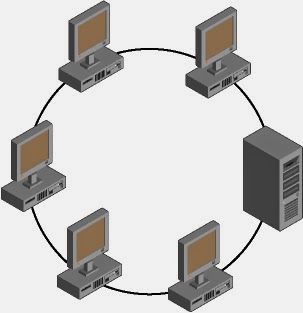Sunday, 25 May 2014
Attachment Unit Interface (AUI)
Connector commonly are used with thick Ethernet cabling. These device used a DB15 connecor to link o the network card.
Hardware utilized in a Bus Topology Network
Both thin Ethernet and thick Ethernet require the following additional network hardware to link the host.
- BNC Connector
- Terminator
- AUI Connector
Wiring standard in a Bus Network
Computer network commonly are linked using network cabling. The following are two wiring standards for communications on a bus network.
10Base2- Also known as thin Ethernet. It allow network segment up o 185 meter on coaxial cable.
10Base5- Also known as thick Ethernet, it allows network segments up o 500 meter in coaxial cable.
10Base2- Also known as thin Ethernet. It allow network segment up o 185 meter on coaxial cable.
10Base5- Also known as thick Ethernet, it allows network segments up o 500 meter in coaxial cable.
Local Area Network
There are basic type of local area network.
- Peer to Peer
- Server Based
Server Based Network- At least one host is dedicated to server functionality. Client computer do not share any information with other computer. All data is stored on the central server . Most corporate networks are based on this methodology. Within a server based network, server can play several roles these roles include the following.
Directory Server- These provide a central directory service for management of users groups and host object to allow for centralized authorization using the central directory.
Files and Print Server- These provide a secure repository for all data. They also can manage point queues that provide access to network. Searchable print resources.
Application Server- These provide the server side of client/server application. In a client/server environment, the client run a small version of the program that allow connectivity to the server. The server side of the application is used to perform processor- intensive quires on behalf of the client. Example of application server included Web server and database server.
Mail Server- These provides electronics message capabilities for the clients of the network.
or
A mail server is a program responsible for receiving routing and delivering e-mail message.
Security Server- These provide security to the local network. If it is connected to any larger networks such as the internet, security; server include firewalls and proxy servers.
Remote Access Server- These enalble external data flow to occur between the network, or alternatively, use the technology known as tunneling or virtual private networks (VPNs) to connect to the remote network over a public network such as the internet.
Security Server- These provide security to the local network. If it is connected to any larger networks such as the internet, security; server include firewalls and proxy servers.
Remote Access Server- These enalble external data flow to occur between the network, or alternatively, use the technology known as tunneling or virtual private networks (VPNs) to connect to the remote network over a public network such as the internet.
Subscribe to:
Comments (Atom)

